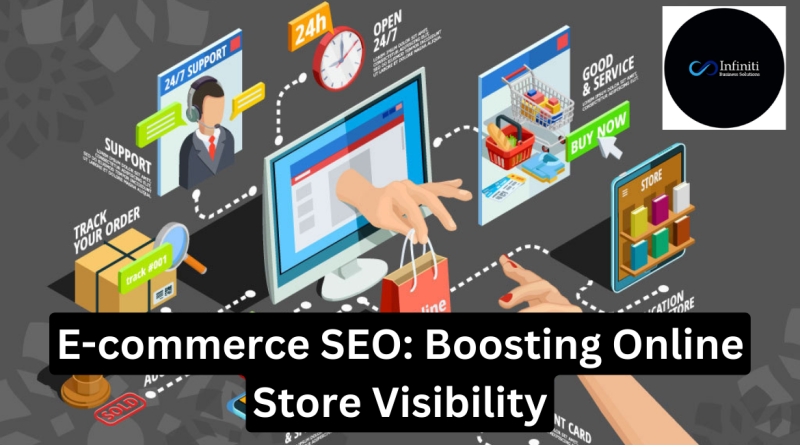Guide for E-commerce SEO: Boosting Online Store Visibility
As consumers increasingly turn to online platforms for their shopping needs, ensuring that your online store is easily discoverable is a key component of a thriving e-commerce strategy. This is where E-commerce SEO (Search Engine Optimization) plays a pivotal role. In this comprehensive guide, we’ll delve into the strategies and best practices to boost the visibility of your online store and drive organic traffic.
If you’re on the hunt for best Ecommerce marketing services, look no further than Infiniti Business Solutions. A trusted top marketing agency all over the USA.
The Importance of E-commerce SEO
E-commerce SEO is the practice of optimizing your online store’s website and product pages to rank higher in search engine results. When potential customers search for products you offer, appearing prominently in search results increases the likelihood of attracting organic traffic. The benefits of effective e-commerce SEO extend beyond visibility; they contribute to enhanced user experience, trust-building, and ultimately, increased sales.
1. Keyword Research and Optimization
Understanding User Intent:
The foundation of any successful SEO strategy is a thorough understanding of user intent. Conduct comprehensive keyword research to identify the terms and phrases potential customers are using to search for products. Consider the different stages of the buyer’s journey, from awareness to purchase, and tailor your keyword strategy accordingly.
Long-Tail Keywords:
In the e-commerce realm, long-tail keywords—more specific and detailed search queries—are particularly valuable. They may have lower search volumes, but they often indicate a more specific intent to purchase. Incorporate these long-tail keywords naturally into your product descriptions, titles, and meta tags.
Optimize Product Pages:
Each product page is an opportunity to target specific keywords. Optimize product titles, descriptions, and meta tags with relevant keywords while maintaining readability and providing valuable information to potential customers. Ensure that your content is unique and compelling, differentiating your products from competitors.
2. Technical SEO for E-commerce Websites
Mobile Optimization:
Given the increasing prevalence of mobile device usage, optimizing your e-commerce site for mobile is not just a suggestion; it’s a necessity. Google prioritizes mobile-friendly websites in its rankings. Ensure responsive design, fast loading times, and a seamless user experience across various devices.
Site Speed:
Page loading speed is a critical factor for both user experience and SEO. Slow-loading pages can lead to higher bounce rates and negatively impact search rankings. Optimize images, leverage browser caching, and utilize content delivery networks (CDNs) to improve your site’s loading speed.
Secure Website (HTTPS):
Security is paramount for e-commerce websites, not only for customer trust but also for SEO. Google considers HTTPS as a ranking factor. Secure your website with an SSL certificate to encrypt data and provide a secure browsing experience for users.
Structured Data Markup (Schema.org):
Implementing structured data markup using Schema.org can enhance how search engines understand your product pages. Rich snippets, such as product ratings, reviews, and prices, can appear in search results, making your listings more visually appealing and informative.
3. Optimizing Product Images and Descriptions
High-Quality Images:
Visual appeal is crucial in e-commerce, and high-quality product images can significantly impact user engagement. Optimize images for size and resolution without compromising quality. Use descriptive file names and alt text to provide context for search engines.
Informative Product Descriptions:
Craft compelling and informative product descriptions that not only appeal to potential customers but also contain relevant keywords. Highlight key features, benefits, and unique selling points. Avoid duplicate content, as this can negatively affect SEO.
Read Also: A Guide for Choosing the Right Web Development Partner
4. User Experience (UX) and Navigation
Clear Site Architecture:
A well-structured and intuitive site architecture improves not only user experience but also search engine crawling and indexing. Ensure that your e-commerce website has a logical hierarchy, with categories, subcategories, and easily navigable product pages.
Intuitive Navigation:
User-friendly navigation is crucial for keeping visitors engaged and guiding them towards making a purchase. Implement clear menus, filters, and search functionality to help users find products effortlessly. Minimize the number of clicks required to reach product pages.
Customer Reviews and Ratings:
Encourage and display customer reviews and ratings on your product pages. Beyond providing valuable insights to potential buyers, user-generated content contributes to fresh and relevant content, signaling search engines about the credibility and popularity of your products.
5. Content Marketing for E-commerce
Blogging for Product Education:
Create a blog section on your e-commerce site to publish informative and engaging content related to your products or industry. Blogging not only provides value to visitors but also serves as an opportunity to target additional keywords and build authority in your niche.
Video Content:
Leverage the power of video content to showcase your products in action, provide tutorials, and engage users. Video content can be hosted on your site, YouTube, or other platforms, contributing to a diverse content strategy that appeals to a broader audience.
6. Social Media Integration and Optimization
Social Signals:
While social signals may not be a direct ranking factor, a strong social media presence can contribute to increased brand visibility and traffic. Integrate social sharing buttons on product pages, and actively share your products on social media platforms.
Visual Platforms:
For e-commerce, visual platforms like Instagram and Pinterest are particularly impactful. Share high-quality images of your products, engage with your audience, and consider utilizing shopping features provided by these platforms.
7. Local SEO for E-commerce
Local Business Profiles:
If your e-commerce business has a physical presence or serves specific locations, optimize your local business profiles on platforms like Google My Business. This ensures accurate information is displayed in local search results.
Local Keywords:
Incorporate local keywords into your content, especially in product descriptions and meta tags. Localized content can attract users searching for products in specific geographic areas.

